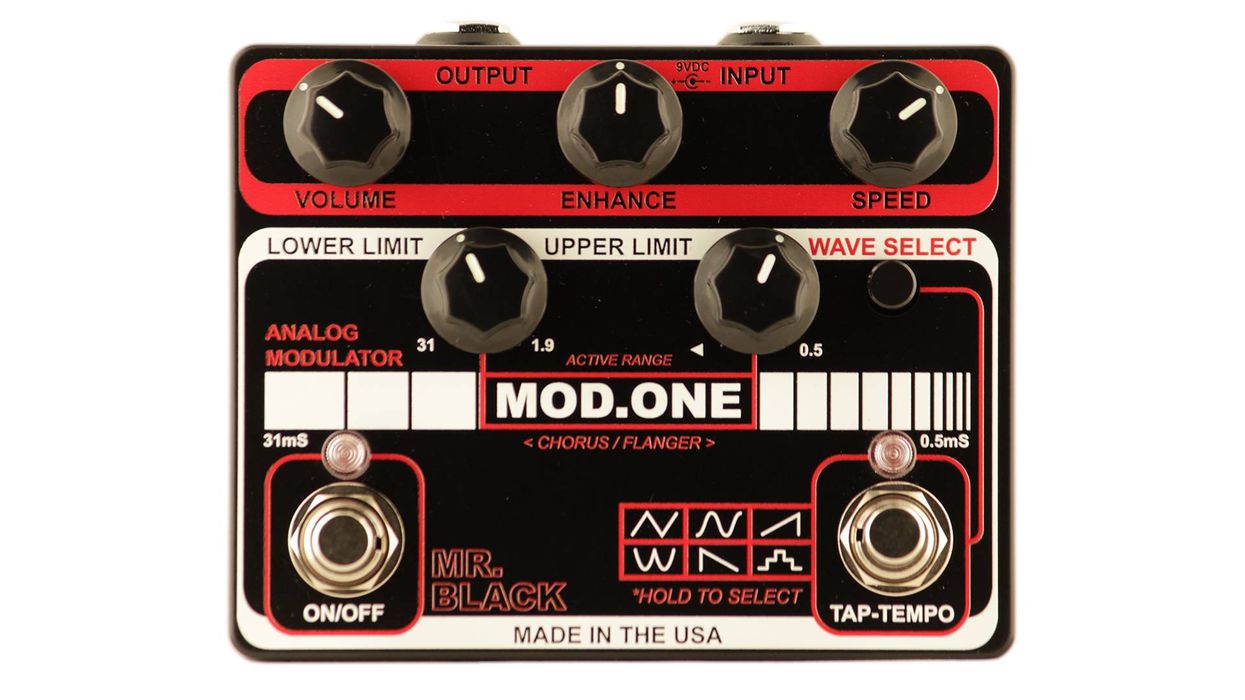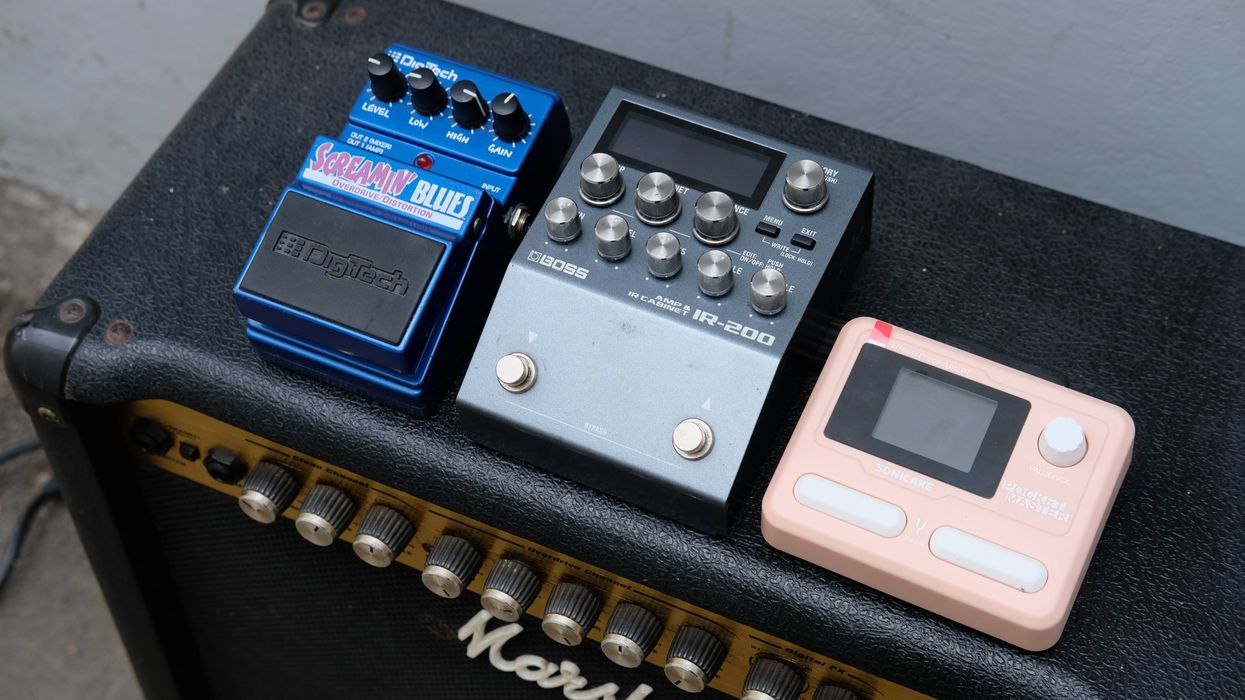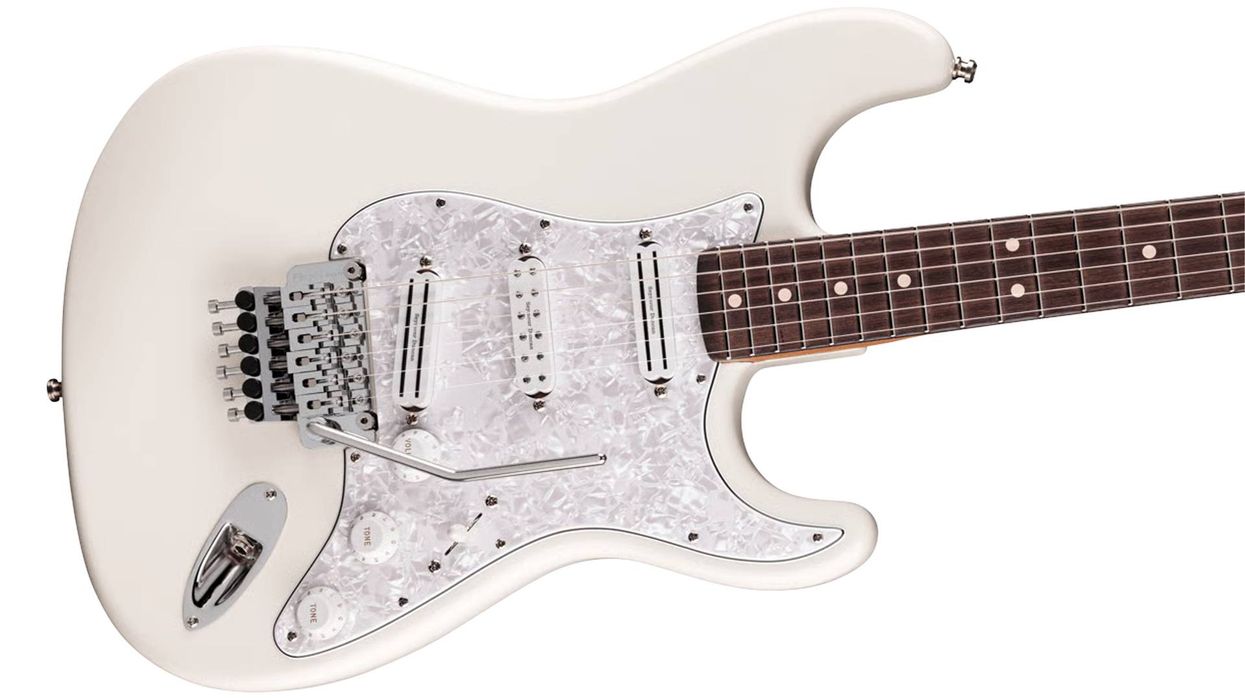Up until recently, U.K.-based Sonuus had been primarily known for its work with guitar-to-MIDI converters. But for all the company’s focus on software and interfaces, the new analog—yes analog—Wahoo pedal proves it’s not quite ready to commit whole-hog to an all-digital future. This dual-filter wah for guitar and bass captures the squawky goodness of vintage-voiced wahs, harnesses the musical potential of LFO and envelope filters, serves up pitch-detect functions, and delivers cool twists on familiar modulation effects. But it also takes advantage of Sonuus’ copious expertise in the digital domain by marrying an analog signal path with digital controls that yield an impressive range of fat-toned effects—up to 100 of which can be stored as presets.
Spaced-Out Box
The first thing most people will notice
about the Wahoo is its not-at-all retro
design (as well as the two convenient roll
bars protecting the knobs from errant
sneakers). At about the same size as a
DigiTech Whammy, it’s not a small pedal.
But for all the sonic resources it puts at
your disposal, many will be happy to ditch
a dated or underutilized box (or two) to
squeeze it on their board.
The top third of the Wahoo’s control panel has an LED readout that registers preset numbers, buttons for scrolling through the presets, and a level knob. Pressing and turning the latter selects the level of preamp gain, the proportion of signal from the two filters, the dry/wet signal, and the output signal. You can also set presets from this section. The middle third controls filter characteristics. You can switch between filters to shape them individually, control the Q (resonance) at high and low frequency extremes, control cutoff frequency in the high and low ranges, shape the filter curve, and select between low-pass and band-pass filters. The lower third is home to the mode selector, which selects LFO, envelope filter, pitch shift, or customized modes.
Envelope mode is essentially an auto-wah, and pitch mode can track notes so the filter cutoff follows the note, or it can track when you bend a note to give a unique auto-wah effect. With patience, vision, and a little time, you can shape these effects in very unique ways. And if you’re into precise signal arrangement, you can use the USB port to plug the Wahoo into your computer and tweak the mode templates with software available on Sonuus.com.
One notable aspect of the Wahoo’s hardware is the presence of a patent-pending position sensor (which the company says will never wear out) instead of a potentiometer to control the wah and filters. If you’re a wah addict, you probably know the hassle of greasing up or changing mechanical pots well, so it’s an intriguing evolution, and it works well on the Wahoo. Sonuus also made improvements to the true-bypass circuit, enhancing transparency and eliminating mechanical pops and cracks during engagement.
Wave After Wave
The Wahoo’s preprogrammed presets alone
are more wide-ranging than could possibly be
covered in this review, but the pedal reveals a
galaxy of possibilities the more you explore—whether you’re looking for familiar sounds
or more far-out textures. Using a Fender
Stratocaster and silverface Fender Bassman, I
set up the Sonuus Wahoo side-by-side with
a Crybaby Classic. The first preset on the
Wahoo is dialed in to simulate the latter, and
moving the rocker to the toe-down position activates the pedal with clickless engagement.
To my ears, the Sonuus seemed the more
precise and sensitive of the two units, with
a broader range of sweep and brighter tone.
The sensor technology is surgically accurate
and actually feels touchy if you’re used to the
clunky dynamic of a standard wah.
Ratings
Pros:
Wide range of high-quality wah, filter, and modulation effects. Easy to use and save presets. Top-notch build quality.
Cons:
Deeper wave-tweaking functions have a bit of a learning curve.
Tones:
Playability/Ease of Use:
Build/Design:
Value:
Street:
$349
Company
sonuus.com
Other notable presets include F91, a phaser with variable speed you control with the treadle. It doesn’t yield an intense, strobe-like/UFO-engine-room pulse, but it’s still very sci-fi sounding. And altering the speed does allow for some unique twists on the phaser effect. Initially, I felt the top end could use more color, so I engaged the filter knob and increased the hi-Q to give the phase a whistle effect when the wave reached its peak. The result was an intergalactic police-siren effect.
Preset F61 is an LFO that uses a saw-up wave with a backbeat and a rate you control via the foot pedal. While the sound never gets too mushy, you can turn the effect level down with the wet/dry control. My Les Paul gave this preset a bit more linear continuity—and therefore better tracking—than I got from single-coils, and with the rocker set about midway, I sat back and ran a few funk-laden riffs using the backbeat as a drum machine. It’s a cool effect, although if you start missing notes or aren’t striking them evenly, the tracking gets a little off and loosens up the beat—but it can be a fun tool for improving your timing, too.
Smaller amps—even solid-state practice amps—still sound very rich, but you’ll want to watch your gain settings to make sure you don’t lose clarity if your amp has less headroom or a lot of inherent compression. Also, because of the wide frequency range of some presets, extreme signal shifting can distort the output or yield shrill sounds at certain wave peaks. You’ll still get some of this distortion if you’re using a tube amp, but a 10" or larger speaker and an amp with a little headroom is definitely preferable for exploring these more radical effects.
The Verdict
The Sonuus Wahoo captures the spirit of
simple synthesis, the vocal responsiveness of
a great wah, and both classic and unusual
modulation effects in a single robust design.
What’s more, it’s extremely functional and
easy to navigate, considering its depth. The
$349 price tag is steep, but this is not a
stompbox of ordinary capabilities either.
And given the quality of both the sounds
and construction, it’s an investment that
may well pay itself back and then some.



























